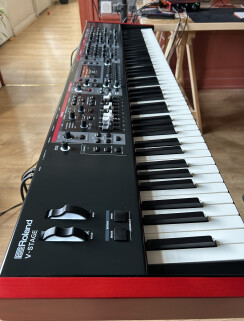At NAMM 2025, Roland unveiled the V-Stage range, which includes the V-Stage 88, a weighted stage keyboard, and the V-Stage 76, a semi-weighted "Waterfall." Stage-wise, Nord Stage's competitor aims for the top of the food chain, with prices ranging from 3490 to 3999 euros (3499 to 3999 dollars). Let's take a closer look.

Design, finishes and ergonomics

The color is bound to raise eyebrows, as red on this type of stage keyboard is in the collective unconscious associated with the Nord Stage, even if Roland isn’t making its first attempt in this red color with the SH-101 (if I’m not mistaken, predating the first Nord Stage), which was a synth available in several colors. After all, Roland can assume that we’re not going to impose a color diktat on them and that red doesn’t belong to Nord. But let’s not be in denial. Having owned a Nord Stage EX88, discovering this Roland also made me think of it in terms of the keyboard layout.
The V-Stage appears overly complex at first glance, but its layout is actually designed to simplify things for a keyboard player. The fonts, white on black, are clearly legible. Zones are clearly defined. The keyboard spans 110 cm and is 17 cm deep (43.3" × 6.7"), so there’s enough room for all the controls. The backlighting is white, sober and effective, without fuss. The 88-key model weighs 21.8 kg (48.1 lbs) and the 76-key model 15.2 kg (33.5).
Main-features-and-philosophy-of-the-V-Stage 88

And that it certainly is. It features 512 scenes to store and 64 presets. A blank introductory scene is also present to give the performer a starting point for customizing the most-used sound. Additional scene packs from Roland Cloud Manager are also announced at the same time as the release.

The buttons are made of soft plastic, quite pleasant to the touch, and sometimes exhibit a little play in the sheathing depending on what’s being used. The push buttons are well-made, and I particularly appreciate the rotary-assignable buttons. The LCD screen (4.3 inches or 10.9 cm) has three colors: red, gray and white. It’s elegant and just the right size.
Detailed presentation of sections and sound engines
.

Organ
This area is the most consequential of the keyboard, and is very comprehensive. It’s easy to get used to and you’ll find everything you’d expect from a keyboard of this level in terms of control, with the transistor and pipe organ in addition to the phonic wheel.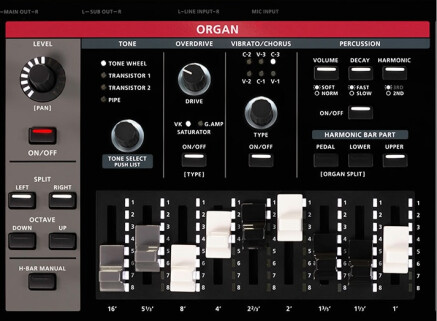
Overdrive is present in this section, which is not always the case with other keyboards. The rotary effect uses a new algorithm to get as close to reality as possible. Not being an organist, it’s hard for me to judge, although I find it works very well, as do the drawbars.
Acoustic piano
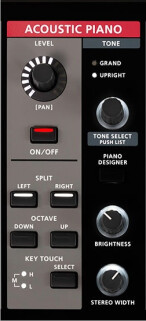
Electric piano
As for the EP section, it’s fairly complete and nicely sized, having apparently benefited 
Synthesizer
The synth section uses the ZEN-Core sound engine, making it possible to use sounds from other products (Fantom or Zenology). This section offers 400 sounds, and there’s plenty of fun to be had with pads, string sounds, basses and leads for solos. 
Good to know, this section supports some of Roland’s so-called “Legends” model extensions through Cloud Manager: JUPITER-8, JUNO-106, SH-106 and JX-8P.
Total Effects, Master and Mic in
A FX panel completes the picture with a display of the usual effects. There are seven reverbs and nine choruses. To finish this linear, the Master with EQ and compression are present, as well as the Mic in with volume.
The keyboard
I won’t talk about the 76 Waterfall keyboard, having received the 88-key one.
I confess to being rather disappointed as a pianist by this PHA-4 action, which is far too light for me and clearly at a lower range level than the more recent PHA-50 action. Of course, this isn’t a stage piano, but a stage keyboard, and it smacks squarely of compromise here to be able to satisfy organ and EP playability. I contacted Roland anyway to ask the reason for this choice, as the PH-50 action is a pleasure to use.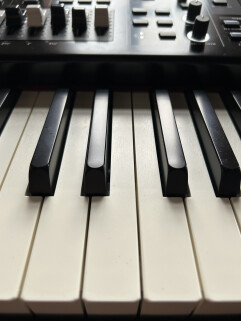
Here’s the answer:
1. The compromise
“We chose the PHA-4 after many discussions with keyboardists around the world about their needs for a stage keyboard. The PHA-50 keyboard is an excellent choice for playing acoustic grand piano sounds, which makes it the ideal choice for an instrument like the RD-2000EX where the main focus of the instrument is on acoustic piano sounds. However, in V-Stage, each of the four sound engines is equally important to the player. Acoustic pianos, electric pianos, organs and synthesizers each have a different key action, so it was very important to us to provide the player with a keyboard action that is best suited to playing all these styles of instrument. The PHA-4 is perfect for these needs; it has the dynamic control needed to play acoustic piano, but is also very enjoyable to play electric piano, while being light enough to allow authentic organ and synthesizer playing.”
2. Weight
“Another important issue for professional players was keeping the V-Stage portable for live performance. If the PHA-50 were mounted on V-Stage, it would add an extra 5kg (11 lbs) of weight to the product, and the dimensions of the instrument would have to be larger to accommodate this action, making the instrument more difficult for the player to carry.”
3. Customization
“The V-Stage-88 is the only Roland product with PHA-4 to be mounted on a wooden baseplate, so it has greater stability than other products with this fingerboard action, and the PHA-4 has also been specifically calibrated for V-Stage’s V-Piano engine for improved playability. Players can also easily set their preferred sensitivity level for the acoustic and electric piano motors from the front panel, also to ensure the best playing feel.”
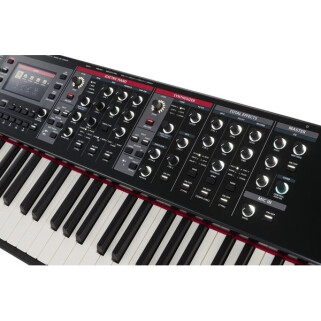
The ivory texture of the keys is pleasant to use, and contrasts are of course possible on this keyboard, which is nevertheless responsive. But why not a new mechanism for a new stage keyboard? It seems to me that this expectation would be quite legitimate given the price.
In conclusion, if you’re a pure pianist and that’s all you do, it’s not certain that you’ll find it to your liking. It might be better to go for the FP-90X, which more strictly piano-oriented.
Sound quality and palette of available sounds
The sounds are excellent quality, and there’s bound to be something for everyone here, as the choice is vast, making it possible to create beautiful scenic ambiences.








Stage connectivity and compatibility
The V-STAGE’s I/O connectivity is comprehensive and up to date:

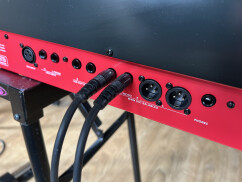
The V-STAGE is equipped with several ports, including a MIDI (5-pin) jack and a pedal socket, so that players can use it for a variety of stage applications.
Using the USB external device port combined with the a-Pro series, it’s possible to play four parts on each keyboard. I particularly like the USB-C connection, which can be connected not only to a PC, Mac or similar, but also to a mobile device.

